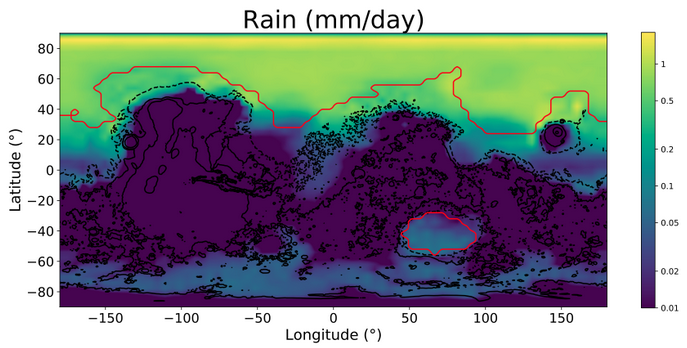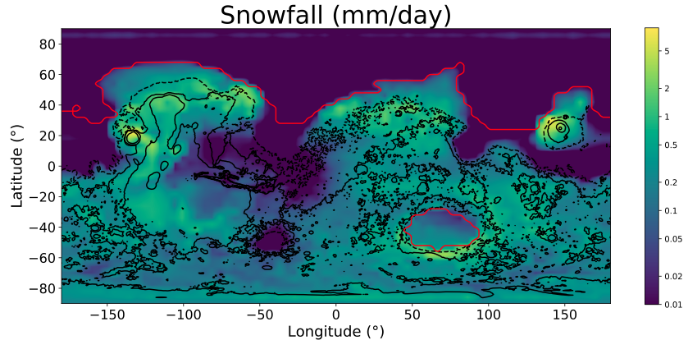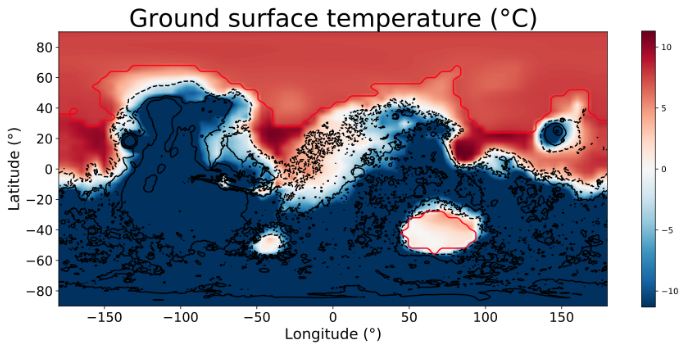Cold late Hesperian Climate
- 1Université Paris-Saclay, CNRS, GEOPS, 91405, Orsay, France (frederic.schmidt@@universite-paris-saclay.fr)
- 2NASA/Goddard Institute for Space Studies, 2880 Broadway, NY, NY 10025, USA
- 3GSFC Sellers Exoplanet Environments Collaboration, Greenbelt, MD, USA
- 4TheoreticalAstrophysics, Department of Physics and Astronomy, Uppsala University, Uppsala, Sweden
- 5Columbia University, 2880 Broadway New York, USA
Introduction
The possibility of a Martian ocean is a topic of debate with strong implications on the habitability of the Red Planet [1]. Geomorphological arguments in favor and against an ocean have been recently reviewed [2]. There is evidence of Martian paleo-shorelines [3] in Deuteronilus (sometimes noted contact No 2) in a geometry close to the current equipotential height [4]. Deuteronilus shoreline seems to be the latest in the last stage of Tharsis induced true polar wander [5].
Recent interpretation of tsunami deposits near the shorelines [6,7] has provided new clues on the debate. In addition, the potential impact crater, at the origin of the tsunami wave has been possibly identified [8]. These new investigations suggest a long-term stable water body 3 Gy ago in the Northern lowland of Mars.
Various scenarios have been investigated to maintain an ocean [1]. If the climate is cold, the ocean should have been entirely frozen shortly after its formation. If warm, the ice-free ocean should have produced intense fluvial erosion of Hesperian terrains. But there is a lack of observation of such extensive valley networks [1]. A cold and wet Mars scenario has been theoretically proposed [9] but the long term stability of an ocean in such a scenario has seldom been explored in 3D-GCMs
Model
We present a fully coupled ocean/atmosphere 3-D General Circulation Model simulations based on ROCKE-3D [10], which is based upon a parent Earth Climate Model known as ModelE2 [11]. This model allows us to estimate the interaction between atmosphere/ocean circulation but also encompasses a surface hydrological scheme.
We assume the solar luminosity to be ∼79% of its current value [12], hence at 3 Gy, the flux at Mars would be 452.8 W.m−2. The ocean shoreline is set to –3900 meters in all runs. This gives an ocean surface fraction of ∼16% which is small in comparison to Earth at ∼71%. The ocean is also shallower than the mean depth for Earth. For this reason the time to bring our ancient Mars model ocean and atmosphere into equilibrium is much shorter (∼100s of years) than would be the case for an Earth like ocean (∼1000s of years). We assume this equilibrium has been reached when the net radiative balance (the difference between incoming and outgoing fluxes) is less than 0.2 W.m−2.
H2 provides a powerful greenhouse component in combination with CO2 as a background gas, but other gas combinations involving CH4 or H2S may have an equivalent radiative effect even if the motivation for their use is lacking. We run simulations with 10% and 20% H2 in a CO2 dominated atmosphere with 0°, 20°, 40°, 60° obliquity, since obliquity can have large excursions from the mean value in the past [13, 14].
Results
Figures 1, 2, 3 show the simulated fields averaged over 10 Martian years for H2=10% and total pressure of 1 bar. Despite an average temperature below 0°C, the ocean is stable due to its low altitude, low albedo and circulation. On land, there is a clear boundary at an altitude of -2000 meters which corresponds to the dichotomy boundary. In the high altitude domain, the surface is mostly frozen and snow precipitation is observed. The extensive accumulation of snow in the highlands can lead to the formation of significant ice sheets that may flow down to the ocean. In the lowest altitude domain, liquid water rain is observed and surface runoff is possible. The rain mainly occurs over the ocean, meaning that annually ocean evaporation is almost fully compensated by rain.

Figure 1: 3D GCM output at 40° obliquity for the rain precipitation. Black contour lines represent altitude level and the red contour line is the paleo-shoreline

Figure 2: same as Fig. 1 for snowfall

Figure 3: same as Fig. 1 for sea/ground surface temperature
Discussion and conclusion
We propose here a fully coupled ocean/atmosphere to investigate the Martian climate 3 Gy ago. It seems that this coupling significantly increases the stability of the ocean due to its circulation [15]. Comparison with observed geological features of the same epoch shall be done in order to validate or invalidate this scenario.
References
[1] Martin Turbet and François Forget, Scientific Reports, 9(1), apr 2019. [2] Zachary I Dickeson and Joel, Astronomy & Geophysics, 61(3):311–317, jun 2020. [3] Timothy J. Parker, et al., Journal of Geophysical Research, 98(E6):11061, 1993. [4] James W. Head et al., Science, 286 (5447):2134–2137, 1999.[5] Robert I. Citron, et al,, Nature, mar 2018. [6] Alexis P. Rodriguez, et al., Scientific Reports, 6:25106–, May2016. [7] Francois Costard, et al., Journal of Geophysical Research: Planets, 122(3):633–649, mar2017. [8] F. Costard, et al., Journal of Geophysical Research:Planets, jul 2019. [9] Alberto G. Fairen, Icarus, 208(1):165–175, July 2010 [10] Michael. Way et al., Astrophysical Journal Supplement Series, 231:12, July 2017 [11] Gavin A. Schmidt et al., Journal of Advances in Modeling Earth Systems, 6(1):141–184, 2014 [12] D. O. Gough et al., SolarPhysics, 74(1):21–34, November 1981, [13] J. Laskar, et al., .Icarus, 170:343–364, August 2004. [14] John C. Armstrong, et al., Icarus, 171(2):255–271, October 2004. [15] Schmidt et al., Nature Geoscience, under review
How to cite: Schmidt, F., Way, M., Costard, F., Bouley, S., Sejourné, A., and Aleinov, I.: Cold late Hesperian Climate, European Planetary Science Congress 2021, online, 13–24 Sep 2021, EPSC2021-717, https://doi.org/10.5194/epsc2021-717, 2021.

